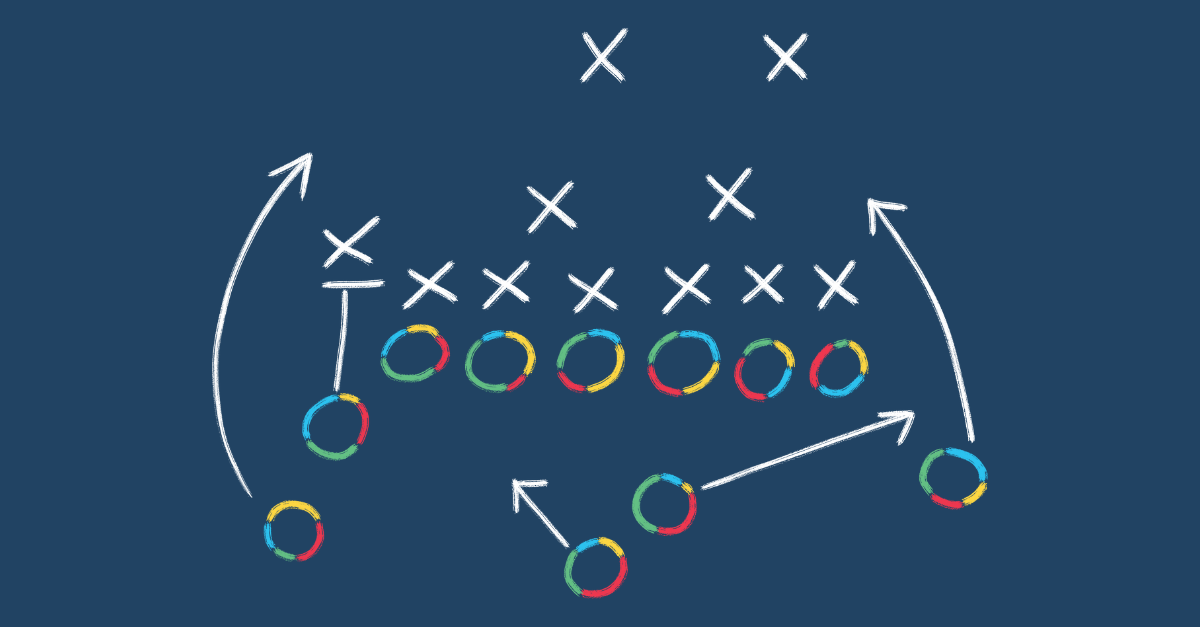Winning team cultures start with a group focused on the goal and trusts each other implicitly. Longtime college football coach Bronco Mendenhall has built winning team cultures — on and off the field — at two major universities by unifying his players and coaches around the Whole Brain® Thinking framework
Mendenhall served as head coach at Brigham Young University (BYU) from 2005-15 and at the University of Virginia (UVA) from 2016-21. Learn why Mendenhall is a superfan of Whole Brain® Thinking and how he helped his staff and players buy into the framework as part of a more extensive cultural transformation that led to wins on the field and in life.
Finding a Framework to Drive Change
In 2005, BYU elevated Mendenhall to head coach after the team endured three consecutive nonwinning seasons. The scope and scale of Mendenhall’s responsibility were overwhelming at first. He knew that to see real change, the football program needed a sustainable foundation — one that was more than just X’s and O’s.
“In the HBDI®, I am Yellow, so I'm a big-picture thinker,” Mendenhall says. “I'm looking to change the world through everything that I do. So I'm applying everything that I take in and apply things holistically.”
But when he became head coach, Mendenhall didn’t know about the Herrmann Brain Dominance Instrument or Whole Brain® Thinking. Only as he dug into the job did he meet organizational behaviorist Paul Gustavson, who introduced him to this framework. Herrmann’s approach “instantly resonated” with Mendenhall, who had experienced other assessments.
“My No. 1 trait that brings me fulfillment is learning. And I couldn't wait to learn, apply and consider how Whole Brain® Thinking might be able to affect our organization,” Mendenhall said.
By understanding his thinking preferences and learning that he is a very Yellow thinker, Mendenhall knew that he needed the support of analytical (Blue), structural (Green), and relational (Red) thinkers to create balance. And Mendenhall saw the value of Herrmann’s approach to uplifting student-athletes in all areas of their lives.
“I see it as a platform to develop young people — this way of thinking and this way of teaching with the Whole Brain® model. … Somehow along the way, the financial and commercial and professional part [of college football] has seemed to replace the true development of a young person,” Mendenhall says.
Incorporating Whole Brain® Thinking Everywhere
Mendenhall quickly embraced Whole Brain® Thinking in every aspect of the BYU football program. Much like a corporate leader would, Mendenhall had his team take the HBDI® assessment, then share and discuss the results within smaller player groups and the entire team. Mendenhall could take the next big step by making it safe for people to share their HBDI® results.
“Every player, on their locker, had their nameplate. You couldn't enter a room in our organization without having to walk past someone's [thinking] preferences,” Mendenhall says. “After the workshops, after the understanding, after the clarity, and after the sharing, then the reinforcement simply happened nonstop around our organization.”
Mendenhall brought Whole Brain® Thinking to his coaching staff, too. While he looked for football acumen and experience, he also considered his thinking preferences and what he needed to surround himself with — especially in pressure-packed situations on game day.
“I needed the Blue and the Green, the function and the form and the statistics, to make sense of the holistic part. And quite frankly, luckily for us and my team, the Red and the interpersonal and the emotional started to diminish under pressure,” Mendenhall says. “So I became more, as my team called it, ‘rocklike,’ which was just steadfast and immovable and not much up and not much down, but just consistent.”
Sign up to our newsletter for the latest insights
Seeing Results in Life, not Just on the Field
Whole Brain® Thinking helped Mendenhall’s BYU and UVA teams enjoy sustained success. BYU won the Mountain West Conference Championship twice in his tenure there. And of Mendenhall’s 17 seasons as head coach, his teams were bowl-eligible 16 times.
But that’s just one measure of the success that Whole Brain® Thinking and the HBDI® have helped him achieve. Mendenhall views his student-athletes' education and personal development as just as important as what they do in their sport.
“If we don't self-correct really quickly, college athletics is just moving into a realm of prolonging adolescence and not developing amazing professionals and family men and women and people,” he says. “The entitlement of the structure that's provided actually is slowing down the self-reliance and the initiative and the discoveries necessary.”
At UVA, his 125 players each had individualized study plans tailored to their learning style, goals and interests. That approach is similar to how the HBDI® helps people understand which tasks they prefer and which thinking styles they favor. And it aligns with Mendenhall’s belief in “this idea of eternal progression. I think you can always be learning and growing and becoming or transforming.”
Mendenhall looks for the individuality in each of his players through the Whole Brain® Thinking framework. He might help a player see that they tend to be a Red thinker — but that doesn’t mean they don’t possess or can’t use the other three quadrants. And Mendenhall’s seen how understanding Whole Brain® Thinking helps with difficult conversations.
“Working diagonally across the circle, man, those are hard relationships. And what if that relationship is with a parent? What if it's with a roommate? And so that's really no one's fault,” he says. “That just means that there hasn't been a point of reference established to say, ‘Right. You only want the facts, and I want to sing a song. No wonder this is hard to communicate.’”
Mendenhall sees value in acknowledging these differences in people’s thinking preferences, especially in diagonal relationships (Green-Yellow or Blue-Red). Showing awareness and empathy defuses tense situations and makes them less personal.
“All of a sudden, your team culture or your staff culture can grow just simply by awareness of, no wonder we've had a hard time. How could we not when our preferences are so different?” he says.
Whole Brain® Thinking has influenced how Mendenhall measures success. There are wins and losses on the football field, of course. There are also graduation rates — his time at BYU and UVA brought the highest graduation rates for football players in school history. And then there’s how his players develop as people.
“The measurement is happening one by one, as seeing who these kids become, what fields they choose, the success they're having, how they're leading, communicating in their own families,” he says.
The Whole Brain® Thinking framework continues to help Mendenhall personally and in his interactions with others. And he’s seen firsthand how the framework can elevate teams and organizations.
“It's not only what I believe, but it's how I've done my job,” Mendenhall says.
Learn more about Mendenhall’s Whole Brain® Thinking journey.












